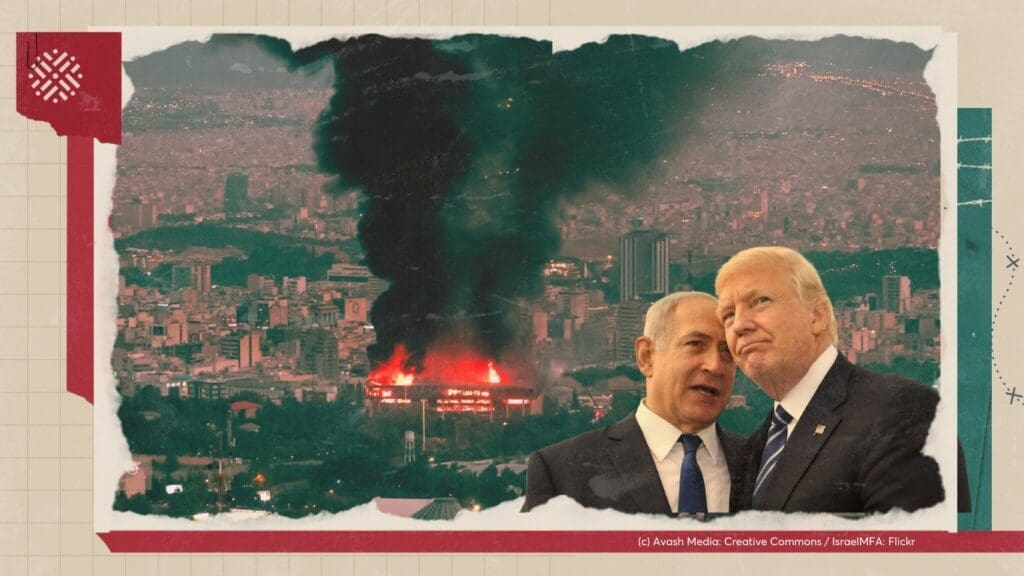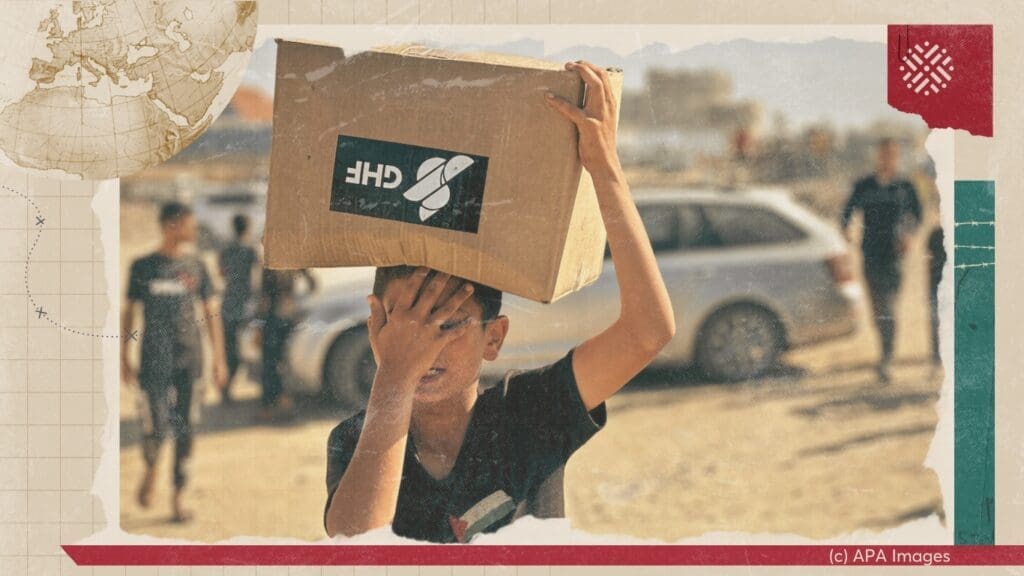- Topics
-
Topics
See our analysis on civil society and how it shapes culture, politics, and policies
Read our insights on the shifting political landscape and what it means for Palestine
Learn more about the policies and practices shaping the Palestinian economy
Strengthen your understanding of the unique conditions for Palestinian refugees across the Middle East
-
- Analysis
-
Analysis
In-depth analysis on existing or potential policies that impact possibilities for Palestinian liberation.
Insights and perspectives on social, political, and economic questions related to Palestine and Palestinians globally.
Concise analysis into a specific policy, its background and implications.
Commentary that brings together insights from multiple analysts.
Compilations of past Al-Shabaka works surrounding a specific theme.
Longer-form, ad hoc projects that seek to confront research questions outside the scope of our regular analysis.
A policy-driven research initiative by Al-Shabaka: The Palestinian Policy Network.
Our monthly webinar series that brings together Palestinian experts.
Featured
On Thursday, June 19, 2025, Israeli Prime Minister Benjamin Netanyahu stood in front of the aftermath of an Iranian strike near Bir al-Saba’ and told journalists: “It really reminds me of the British people during the Blitz. We are going through a Blitz.” The Blitz refers to the sustained bombing campaign carried out by Nazi Germany against the UK, particularly London, between September 1940 and May 1941. With this dramatic comparison, Netanyahu sought to elicit Western sympathy and secure unconditional support for his government’s latest act of military escalation and violation of international law: the unprovoked bombing of Iran. This rhetorical move is far from new; it has become an enduring trope in Israeli political discourse—one that casts Israel as the perennial victim and frames its opponents as modern-day Nazis. Netanyahu has long harbored ambitions of striking Iran with direct US support, but timing has always been central. This moment, then, should not be viewed merely as opportunistic aggression, but as part of a broader, calculated strategy. His actions are shaped by a convergence of unprecedented impunity, shifting regional dynamics, and deepening domestic political fragility. This commentary examines the latest escalation in that context and discusses the broader political forces driving it. Yara Hawari· Jun 26, 2025Launched on May 26, 2025, and secured by US private contractors, the new Israeli-backed aid distribution system in Gaza has resulted in over 100 Palestinian deaths, as civilians navigated dangerous conditions at hubs positioned near military outposts along the Rafah border. These fatalities raise grave concerns about the safety of the aid model and the role of US contractors operating under Israeli oversight. This policy memo argues that the privatization of aid and security in Gaza violates humanitarian norms by turning aid into a tool of control, ethnic cleansing, and colonization. It threatens Palestinian life by conditioning life-saving aid, facilitating forced displacement, and shielding the Israeli regime from legal and moral responsibility. It additionally erodes local and international institutions, especially UNRWA, which has been working in Gaza for decades.
Yara Hawari· Jun 26, 2025Launched on May 26, 2025, and secured by US private contractors, the new Israeli-backed aid distribution system in Gaza has resulted in over 100 Palestinian deaths, as civilians navigated dangerous conditions at hubs positioned near military outposts along the Rafah border. These fatalities raise grave concerns about the safety of the aid model and the role of US contractors operating under Israeli oversight. This policy memo argues that the privatization of aid and security in Gaza violates humanitarian norms by turning aid into a tool of control, ethnic cleansing, and colonization. It threatens Palestinian life by conditioning life-saving aid, facilitating forced displacement, and shielding the Israeli regime from legal and moral responsibility. It additionally erodes local and international institutions, especially UNRWA, which has been working in Gaza for decades. Safa Joudeh· Jun 10, 2025In this policy lab, Mariam Barghouti and Sharif Abdel Kouddous join host Tariq Kenney-Shawa to discuss Israel’s targeted assassination campaign against Palestinian journalists, the complicity of Western media in normalizing these crimes, and how this silence allows Israel to get away with genocide.
Safa Joudeh· Jun 10, 2025In this policy lab, Mariam Barghouti and Sharif Abdel Kouddous join host Tariq Kenney-Shawa to discuss Israel’s targeted assassination campaign against Palestinian journalists, the complicity of Western media in normalizing these crimes, and how this silence allows Israel to get away with genocide. Mariam Barghouti· May 28, 2025
Mariam Barghouti· May 28, 2025
-
- Resources
- Media & Outreach
- The Network




Using Indigeneity in the Struggle for Palestinian Liberation
Overview
On Indigenous People’s Day in 2018, several Palestinian human rights organizations released a statement that called on the international community “to center Native history as the necessary beginning of historical reconciliation and a collectively emancipatory process of decolonization.” The statement demonstrated how indigeneity has recently re-emerged within the discourse on Palestine and is becoming a central facet of political mobilization. It also highlighted the increasing links between Palestinians and indigenous communities across the globe and the collective nature of decolonization, which constitute important tools in the ongoing struggle against settler colonialism worldwide.1
But what does this mean in practice for Palestinians engaged in the liberation struggle and how can it be harnessed to further Palestinian rights and sovereignty?
This commentary addresses these questions by fleshing out the notions of settler colonialism and indigeneity and the relationship between the two through an exploration of the process of Israeli settler colonialism that created Palestinian indigeneity. It then discusses the limitations of the application of international law to indigenous struggles and concludes with thoughts on how to better incorporate the notion of Palestinian indigeneity in the Palestinian quest for freedom, justice, and equality.
Settler Colonialism and Indigeneity
Cases of settler colonialism have their particularities, though they have much in common. Indeed, while there are characteristics unique to the colonial experience in Palestine, the Zionist project is not exceptional as it follows a pattern of European invasion and domination. Similar to other settler colonial movements, the early Zionists claimed European superiority. Yet at the same time they claimed to be indigenous returnees to Palestine based on biblical narratives. In this way they were able to put forward the narrative that they were the rightful owners of the land. For example, the notion that only the Zionist settlers can make the “desert bloom” in Palestine is both a reference to the biblical narrative and therefore their supposed autochthonous “indigeneity,” as well as to their ostensible superiority in culture and knowledge and the productivity characteristic of European capitalism.
Thus the Zionist movement both used biblical autochthonous indigeneity and acknowledged Zionism as a colonial endeavor. Zionist leader Chaim Weizmann exemplified the colonial stance in the following 1947 statement:
Other peoples have colonized great countries, rich countries. They found when they entered there backward populations. And they did for the backward populations what they did…I would like to say that, as compared with the result of the colonizing activities of other peoples, our impact on the Arabs has not produced very much worse results than what has been produced by others in other countries.
Weizmann and his peers not only acknowledged the colonial nature of Zionism, they also regarded the “Arabs of Palestine” with similar disdain as other colonialists did with other native peoples.
The Zionist movement established various agencies that sought to help European Jews appropriate land and settle in Palestine, such as the Palestine Jewish Colonization Association. It worked to dominate the indigenous people to make room for settlers. The settlers as well as the indigenous people understood the nature of this settler colonial enterprise. Indeed, during this period many Palestinians were worried about the “settle to replace” impetus behind the Zionist movement, and continuously objected to both British and Zionist colonialism in Palestine through public demonstrations, official petitions, political mobilization, and writing in the Palestinian press. Two main newspapers, Al-Karmil and Falastin, frequently published on Zionism and its impact on Palestine and Palestinians.
Later, in the decades following the 1948 Nakba, Palestinian scholars and revolutionaries engaged with the notion of indigeneity through work on settler colonialism. In 1965 Fayez Sayegh published the paper “Zionist Colonialism in Palestine,” which describes Israel as a “settler state” and explains that its racist characteristic is not acquired but “inherent in the very ideology of Zionism.” This early work is particularly important as it discusses the settler colonial reality in Palestine before the 1967 Israeli occupation of the West Bank, Gaza Strip, and Golan Heights and stresses the colonial nature of the Zionist enterprise from its inception, countering the common assumption that the “problem” lies with Israel’s 1967 occupation.
Scholarship in this vein followed Sayegh’s article, including George Jabbour’s book, Settler Colonialism in Southern Africa and the Middle East (1970), Maxime Rodinson’s Israel: A Settler-Colonial State? (1973), and Elia Zureik’s The Palestinians in Israel: A Study of Internal Colonialism (1979). These later works linked Israel’s policies with those of apartheid South Africa, contributing to an emerging Western academic current that centered settler colonialism in its analysis of Israel.
In a 1982 interview with Giles Deleuze, founder of the Journal for Palestine Studies Elias Sanbar stated:
We are also the American Indians of the Jewish settlers in Palestine. In their eyes our one and only role consisted in disappearing. In this it is certain that the history of the establishment of Israel reproduces the process which gave birth to the United States of America.
This comparison of the Palestinian struggle to that of the indigenous peoples on Turtle Island (as many indigenous people refer to the North American continent) allows an understanding of the structures of power and domination that settler states share. Still, Chair of the Palestine Liberation Organization (PLO) Yasser Arafat, holding the commonly-held view of indigenous peoples as vulnerable and primitive, dismissed this comparison as far back as the 1980s in an attempt to reject notions of defeat and assert the steadfastness of the Palestinian people. He did so perhaps most infamously in 2004 when he proclaimed that Palestinians “are not Red Indians” during his confinement in his Ramallah compound.
Yet in the 1960s and 1970s the PLO had primarily modelled its agenda, goals, and tactics on another struggle against settler colonialism: the Algerian Front de Libération Nationale (FLN), which had triumphed over French settlers. The PLO, identifying similar structures of invasion, sought camaraderie and expertise from Algerian leaders. The PLO would also later seek links with the ANC in their struggle against apartheid – the governing structure adopted by the South African settler colonial regime.
Comparing the Palestinian struggle to that of the indigenous peoples of North America allows an understanding of the structures of power and domination that settler states share Share on XHowever, scholars and Palestinian leaders put the application of the settler-colonial paradigm to Palestine and affiliation with decolonial struggles on hiatus for several decades. Whereas in the first era of settler colonialism they had linked the history and political ideology of Zionism and the creation of Israel to the political project of Palestinian liberation, in the second wave they focused on Zionist ideology and political structures in terms of land policies, dispossession, Judaization, and infrastructures of control. This occurred particularly with the advent of the Oslo Accords in the early 1990s, which framed Israeli settler colonialism as two conflicting national movements that would find peace within a two-state paradigm. At the same time, Palestinian civil society grew and NGOs began to focus on achieving freedoms within an international law framework and through rights-based advocacy. The limitations of this framework would soon become clear: Not only did it omit concepts such as liberation and sovereignty, it also limited the discussion of Palestine and Palestinians to the 1967 territories.
The past decade has seen a re-emergence of settler colonialism as an academic and analytical tool to examine Israel. The establishment of the journal Settler Colonial Studies, various edited collections, and an increase in academic events and scholarly production focusing on the topic have institutionalized settler colonialism as an academic field. However, there is a notable difference between the renewed focus on settler colonialism and its earlier usage as part of a revolutionary practice. Earlier works were tied to the political project of the PLO, whose goal at that time was to liberate all of historic Palestine from Zionist settler colonialism. In contrast, recent scholarship has emerged from the Western academy, which is not only increasingly neoliberal but also tends to favor a “de-politicization” of scholarship. Work that is challenging this environment by seeking to politicize and dismantle knowledge hierarchies is fighting an uphill battle.
The Israeli Zionist project is one of expansion and erasure of the indigenous Palestinian population. Scholarly work using this analytical framework has grown, yet indigeneity has not had the same level of engagement as settler colonialism, though the settler colonial paradigm necessitates it. While settler colonialism speaks to the Israeli state’s ongoing structure of violence and describes a situation of continuous replacement, indigeneity speaks to life before this structure, resistance during it, and visions for the future. In other words, indigeneity helps Palestinians articulate what they stand for and what they want.
Indeed, indigenous peoples are those who have suffered the settler colonial invasion and continue to suffer the subsequent structures of elimination. In Palestinian poet Mahmoud Darwish’s 1992 poem “The ‘Red Indian’s’ Penultimate Speech to the White Man,” he describes the settler-colonial logic of power and erasure and, unlike Arafat, likens the Palestinian case to the American one, adopting the voice of an indigenous American and pointing to a wholly dominating, continuous structure:
Columbus, the free, looks for a language
he couldn’t find here,
and looks for gold in the skulls of our good-hearted ancestors.
He took his fill from our living
and our dead.
So why is he bent on carrying out his war of elimination
from the grave, until the end?2
Indigenous peoples must be understood within this structure that persists after the initial event of invasion, described by Darwish as a “war of elimination” even after death.
Indigeneity and International Law
After the Oslo Accords, the Palestinian leadership dropped much of its revolutionary discourse and adopted a narrative that followed the international law framework. The NGO-ization of Palestine and the focus on foreign donor agendas that emerged from Oslo has also led much of Palestinian civil society to use terms based in international law to articulate demands for rights. In 2007 the UN adopted the Declaration on the Rights of Indigenous Peoples (UNDRIP) in an attempt to further the rights of global indigenous peoples within an international law framework. While many celebrated UNDRIP despite its status as a non-binding document, it also faced serious criticism and debate, particularly from indigenous communities who felt that not only was it limited in its description of indigenous peoples, but that it also did not allow for indigenous sovereignty given the centrality it placed on maintaining the territorial integrity of existing nation states.
Following the main parameters of international law, UNDRIP takes the state as a given legal and political framework, as noted by Article 46(1):
Nothing in this Declaration may be interpreted as implying for any State, people, group or person any right to engage in any activity or to perform any act contrary to the Charter of the United Nations or construed as authorizing or encouraging any action which would dismember or impair, totally or in part, the territorial integrity or political unity of sovereign and independent States.
While UNDRIP frequently refers to the right to self-rule, it excludes the right of national independent self-determination and external sovereignty, which remains an aspiration for many indigenous peoples, including Palestinians. The declaration refers rather to indigenous autonomy or self-rule in internal affairs in order to preserve cultural identity. It therefore undermines much of the political aspirations of indigenous peoples as understood by the communities themselves. Of course, “sovereignty” means different things to different indigenous peoples, ranging from internal self-rule and cultural preservation and integrity to external self-rule through a process of decolonization. The former means autonomy within existing state structures while the latter connotes a de(con)struction of existing power structures.
This legal analytical approach to indigeneity also views settler colonialism as an event and not a structure. By failing to frame settler colonialism as a continuous process – and thus failing to use a settler colonial framework – the declaration misses many historical and contemporary injustices and leaps to a “post-conflict” situation by legitimizing contemporary colonial states’ existence. Moreover, the declaration lacks a serious discussion of a process of decolonization or elements that could contribute to such a process, such as historical justice processes or repatriation. Essentially, the legalization of indigenous struggles limits indigenous modes and ways of imagining a decolonized future.
Hence the UNDRIP not only undermines the political aspirations of many indigenous peoples; it also limits them to a certain definition. As such, many of those working on Israel’s suppression of Palestinian rights within the field of international law have preferred frameworks such as apartheid, particularly because apartheid is considered a serious crime under international law and has attracted international solidarity in the struggle against it. However, outside of international law, it is clear that apartheid and indigeneity are not mutually exclusive terms and that apartheid has been a mechanism through which to control and manage indigenous peoples.
The legalization of indigenous struggles limits indigenous modes and ways of imagining a decolonized future Share on XYet the use of indigeneity is more complex in the Palestinian case. For example, some who advocate for Palestinian Bedouin rights in the Naqab region have utilized indigeneity when working to secure rights for this group. Yet rather than affirm Bedouins’ rights as part of the Palestinian people as a whole and therefore work toward their entitlement to collective and individual rights, indigeneity has served as a mechanism of fragmentation. By privileging Bedouin indigeneity and not considering other Palestinians indigenous, this advocacy strategy puts the Bedouins in a minority category, dismembers it from its Arab and Palestinian contexts, and reinforces the stereotype of indigenous peoples as tribal and frozen in time.3
Recognizing Palestinian Bedouins as having a distinct culture and identity while also being part of the greater community of Palestinian people is crucial to a nuanced understanding of their struggle. The example of Palestinian Bedouins emphasizes the important intersections between indigeneity and nationalism, demonstrating that the two are not mutually exclusive. Rather, indigeneity can collectivize the experience of a national struggle.
It is important to note that this commentary’s critique and the reservations in it regarding the evolving legal discourses and categories of indigeneity are not to suggest the rejection of these discourses entirely. Rather, the analysis aims to stress the limits of “legal indigeneity” in particular and that of international law in general, and to point out the need to incorporate a more holistic understanding of indigeneity and indigenous aspirations of decolonization into the Palestinian national narrative.
An Indigenous Future
Today Palestinians continue to be geographically fragmented across Israel, the West Bank, and the Gaza Strip, and are scattered over the world in exile. Indigeneity connects these fragments to a single experience – the process of settler colonialism, also known as the continuous Nakba, or al-Nakba al-mustimirrah. It also connects these fragments to Palestine, their center of gravity. Indigeneity as a paradigm and an identity offers a focus and a re-centering of indigenous peoples that spans cultures, languages, and epistemologies. It places indigenous knowledge and understanding, particularly resistance to invasion and attempts at erasure, at its core. It offers a radical re-thinking of knowledge and knowledge production, in particular questioning what knowledge and historical sources are considered worthy and reliable.
This paradigm not only increases Palestinians’ understanding of their past and present, but also furthers their thoughts about the future. Indigeneity demands that Palestinians refocus their struggle on decolonization and liberation for all Palestinians. In this sense, it renders the current frameworks for “territory” and “negotiations” unsatisfactory in terms of delivering freedom and justice. Palestinian futures must be addressed in all their fragments, and this can only be done within an understanding of Zionism as a settler colonial project that rendered the Palestinian people indigenous. It is the colonial encounter that created the native and their new political reality. Indigeneity should therefore be treated as a political reality whose transformation comes with decolonization.
Harnessing indigeneity as a tool to achieve Palestinian rights and sovereignty faces serious challenges. The resurfacing of indigeneity and the settler colonial analysis remains largely found among academics and in certain activist spaces, with limited translation into the political arena. The Palestinian political representation within Israel has mostly sought to achieve “equal” rights within the state’s framework, and the PA seeks to establish a state in the West Bank and the Gaza Strip (although this is now in question) within international legal parameters. Both have failed not only to achieve their political goals, but also to adequately incorporate the Palestinian refugees and their right to return and restitution.
Indigeneity offers a way to rethink the Palestinian political project as one that understands all Palestinians as indigenous people facing attempted erasure Share on XThe concepts of indigeneity and nationalism both contradict one another and overlap. Indigenous peoples can and do have nationalist aspirations. Just as other communities, they are pluralistic and their political and economic structures and aspirations may change. Yet an ongoing structure of elimination attempting to erase their indigeneity as well as hopes of constituting a nation defines their experience and aspirations. Indigeneity as a result offers a way to rethink the Palestinian political project as a more encompassing one that understands all Palestinians, wherever they may be, as indigenous people facing attempted erasure.
Moreover, indigeneity demystifies the Zionist project as something unique to Palestine and places it within a global context of settler colonial projects. This allows Palestinians to draw solidarity links with other indigenous peoples and to recognize intertwining threads of oppression. Considering a decolonial future is an important part of the (re)-shifting of the political paradigm. Indeed, Palestine’s struggle for freedom and justice must be recalibrated so that it re-centers Palestinian visions for the future, not a single vision imposed by outside forces determined to maintain the status quo.
Yara Hawari
Ahmad Amara
Latest Analysis
Timed for Impunity: Israel’s War on Iran
Outsourcing Occupation: US Private Contractors in Gaza
Israel’s War on Palestinian Journalists
We’re building a network for liberation.
As the only global Palestinian think tank, we’re working hard to respond to rapid developments affecting Palestinians, while remaining committed to shedding light on issues that may otherwise be overlooked.